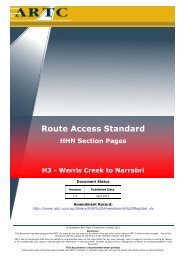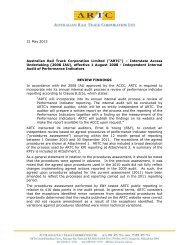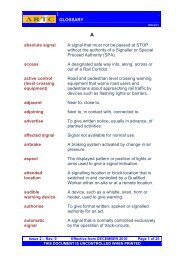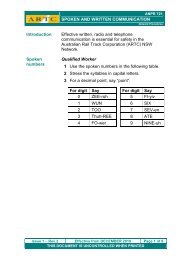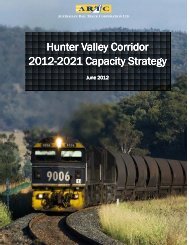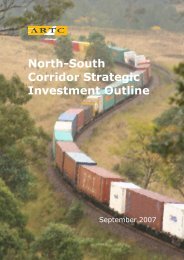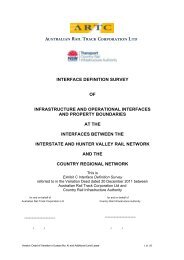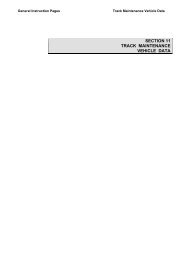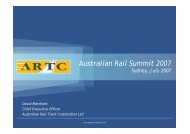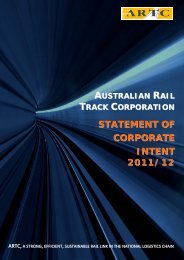MelbourneâBrisbane Inland Rail Alignment Study - Australian Rail ...
MelbourneâBrisbane Inland Rail Alignment Study - Australian Rail ...
MelbourneâBrisbane Inland Rail Alignment Study - Australian Rail ...
You also want an ePaper? Increase the reach of your titles
YUMPU automatically turns print PDFs into web optimized ePapers that Google loves.
This 50% cost pass through assumption was made<br />
because the main competitive constraint on the rail<br />
freight rate is the road freight rate and it is understood<br />
that rail profit margins in the corridor are not high.<br />
Train operators would make a choice between<br />
passing on cost savings to their freight customers<br />
by way of a lower rail price and increasing their<br />
profit margins. For the purpose of the market share<br />
analysis, it was therefore considered that the pass<br />
through of cost savings would be less than 100%,<br />
with 50% being the working assumption (where cost<br />
savings are shared equally between train operators<br />
and customers). This reflects a balance between<br />
passing on all gains (unlikely if margins are low) and<br />
passing on none (unlikely due to road and other<br />
competition). A higher degree of pass through would<br />
lower the inland railway freight rate and increase the<br />
forecast uptake of the railway by 8–10% if 100% cost<br />
pass through were assumed rather than 50%. In the<br />
economic appraisal presented later in this report, the<br />
full saving is captured to reflect that either the train<br />
operators or freight customers will benefit.<br />
As shown in Figure 6, coastal rail train operating<br />
costs account for 83% of total rail linehaul (terminalto-terminal)<br />
costs. The linehaul price offered for freight<br />
carried on <strong>Inland</strong> <strong>Rail</strong> would therefore be 13.6% lower<br />
than the coastal route with 50% pass through of a 33%<br />
reduction in operating costs. 9 By 2020, pick up and<br />
delivery costs were assumed to account for 35% of the<br />
door-to-door price on rail, and these were assumed to<br />
be unaffected by above-rail operating efficiencies –<br />
the overall reduction in door-to-door rail prices is<br />
therefore 9.2%.<br />
Table 8 shows that when pick up and delivery costs are<br />
incorporated in the inland railway door-to-door price,<br />
the price of freight carried on <strong>Inland</strong> <strong>Rail</strong> is estimated<br />
to be 52.2% of that applying to road transport. This<br />
compares with 57.6% for the coastal railway. These<br />
relativities reflect the expected increases in road freight’s<br />
costs due to fuel and labour cost movements in the<br />
years to 2020.<br />
Transit time<br />
The survey confirmed that, other than for express freight<br />
customers, delivery between Melbourne and Brisbane<br />
or vice versa, between early evening one day and early<br />
morning 2 days later, is satisfactory. This is readily<br />
achieved by the optimum route developed in Chapter 5<br />
which has a 20.5 hour terminal-to-terminal transit time<br />
– or 25.5 hours door-to-door once an assumed pick up<br />
and delivery time of 5 hours is added.<br />
ARTC aims to achieve a time of 26.5 hours, terminalto-terminal,<br />
on the upgraded coastal railway. However<br />
discussions with the technical consultants and operators<br />
suggested that it may be challenging to achieve both<br />
shorter journey time and improved reliability. Therefore,<br />
a 27.5 hour terminal-to-terminal time has been assumed<br />
for the coastal railway. With 5 hours for pick up and<br />
delivery, this gives a total transit time of 32.5 hours.<br />
Very little freight was identified which was sensitive<br />
to transit time on its own. Most customers would<br />
prefer faster transit times to improve reliability, and this<br />
preference has been captured in the parameters. The<br />
types of commodities which require fast transit are<br />
usually perishable in nature, such as some agricultural<br />
products. For these goods there was an inherent<br />
preference for road freight because of its reduction<br />
in double handling as well as its faster door-to-door<br />
transit time.<br />
Further discussion on the transit time identified<br />
for <strong>Inland</strong> <strong>Rail</strong> is presented in Box 3.<br />
Reliability<br />
In this study, reliability is defined as the percentage of<br />
trains that arrive within 15 minutes of their scheduled<br />
arrival time (e.g. 87.5% reliability suggests that 87.5%<br />
of trains arrive within 15 minutes of timetable).<br />
In the past, rail reliability has been poor. In 2004 only<br />
45% of trains arrived within 15 minutes of scheduled<br />
arrival time. In 2007–08 62% of scheduled services<br />
on the interstate network entered the ARTC network<br />
on time and 58% exited on time. 10 However ARTC<br />
aims to achieve 75% when current track upgrading is<br />
completed in 2010. In its assessment of the Stage 1<br />
Northern Sydney Freight Corridor, the Northern Sydney<br />
Freight Corridor project team estimates the coastal<br />
railway will achieve 77% reliability from 2015. On this<br />
basis, 77% reliability has been assumed for the coastal<br />
railway, alongside a reduction in linehaul transit time<br />
to 27.5 hours. 11 It has been assumed that an inland<br />
railway, being less congested and avoiding Sydney,<br />
would achieve 87.5% reliability (and reliability of 95%<br />
could be achieved if up to 3 hours slack was built into<br />
the timetable).<br />
<strong>Rail</strong> operators and customers have indicated reliability<br />
has already improved since 2006 and 2007, although<br />
recent history is only just beginning to be reflected<br />
in observed market shares because of the lead time<br />
customers require to implement a change in mode.<br />
Trucks are extremely reliable at around 90–98%.<br />
9<br />
50% pass through of a 33% reduction in 83% of the components of linehaul rail price (so reduction in linehaul price is<br />
50%*83%*33%=13.6%). Similarly, the effect on door to door price is a 50% cost pass through of a 33% reduction in<br />
63% of the cost components of door-to-door price (so reduction in door-to-door price is 50%*33%*56%=9.2%)<br />
10<br />
ARTC 2008, ARTC Annual Report 2008, p 18<br />
11<br />
Northern Sydney Freight Corridor project team<br />
3. Demand for <strong>Inland</strong> <strong>Rail</strong><br />
ARTC • Melbourne–Brisbane <strong>Inland</strong> <strong>Rail</strong> <strong>Alignment</strong> <strong>Study</strong> – Final Report<br />
13



